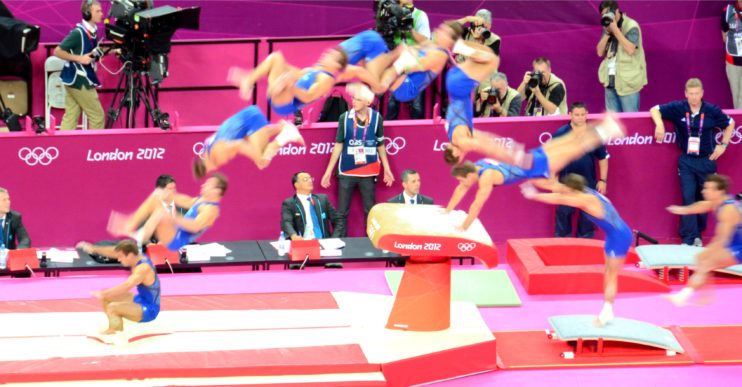Hello, gymnastics community! Today in this post I will be discussing “the vault” to help you understand more about it.
Have you ever been to a meet or to a practice and wonder what that giant object is that your gymnast uses to perform a skill? You know, the giant thing your gymnast runs towards with all his/her might? The thing that she/he does a front tuck or a handspring off of? Well, my friends, that is called the vault!
What is the vault?
The vault is part of the artistic gymnastics and is one of the events at a gymnastics meet. You may look at the vault and think that it is easy for gymnasts to perform on, but let me tell you something…it definitely is not and is totally more complicated than it looks.
The vault event is super fast. What I mean by that is that you literally can not blink or you will miss the entire thing! So, if your gymnast is competing in meets and will be performing on the vault, I highly suggest becoming a “stare contest” champion.
Also read: Best Gymnastics Vault for Home
How big is the vault?
The typical vault is about 4 feet high and 3 feet wide. Intimidating for a small gymnastic, you would think, right? WRONG! Do not think for even a second that your gymnast is scared of that thing because of how big it is; your gymnast will surely surprise you!
What are the parts of the vault?
There is a spring table that is placed right in front of the vault for your gymnast to run and jump on to give him/her the momentum she/he needs to perform the skill she/he needs to do.
The top of the vault is called “the table”. This is the part of the vault that your gymnast will put his/her hands on to push off and perform a skill. The table is metal but has a padded and bouncy cover to help your gymnast get some power.
It also is to help support your gymnast’s arms and hands because it would definitely hurt if it was just metal completely, in fact it could also cause an injury. The table is also angled to accommodate your gymnast.
What are the different types of vaults?
There are five different types of vaults, called families, for both men and women.
- Direct vaults
- Vaults with 1/1 turn in the first flight phase
- Handspring and Yamashita style vaults
- Vaults with 1/4 to 1/2 turn in the 1st flight phase (Tsukahara)
- Round-off entry vaults (Yurchenko)
- Handspring, Yamashita, round-off with or without longitudinal-axis (LA) turn in 1st and/or 2nd flight phase
- Handspring forward with/without 360° turn in 1st flight phase, salto forward with/without LA turn in 2nd flight phase
- Tsukahara style vaults
- Yurchenko style vaults
- Round-off with ½ LA turn in 1st flight phase, salto forward with or without LA turn in 2nd flight phase (Khorkina-style vaults)
Men and women skills are different for different levels. For example, female gymnasts that are level four, five and six perform front handsprings on the vault whereas male gymnasts do not perform that until they are on level six.
Female gymnasts that are level three perform handstand flatbacks on the vault. Male gymnasts that are level four perform straight jumps on the vault and male gymnasts that are level five perform front tucks (landing on mats of course).
Please feel free to comment below to give us (and our readers) any feedback, advice, or experiences! I am sure there are some things that I have missed!
Photo Source: Flickr

